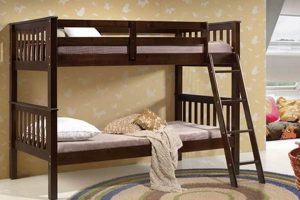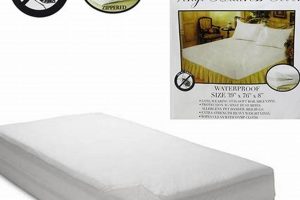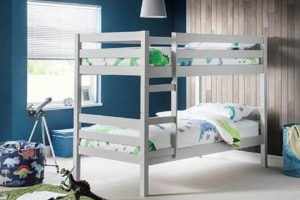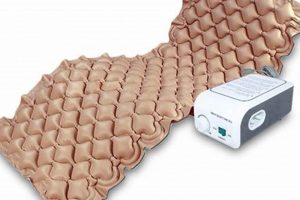The dimensions of a sleep surface intended for young children transitioning from a crib are generally standardized. Typically, this measures approximately 28 inches wide by 52 inches long. This standardized measurement ensures compatibility with most available frames designed for this developmental stage.
Adherence to a recognized dimensional standard offers several advantages. Primarily, it ensures safety by fitting snugly within the bed frame, minimizing the risk of entrapment. Furthermore, using established measurements facilitates easier selection of appropriate bedding and accessories, contributing to a cost-effective and convenient purchasing experience. Historically, this standardization developed to promote infant and toddler safety and to streamline manufacturing processes.
Understanding these standard dimensions is crucial when selecting a sleeping arrangement for a young child. The following sections will elaborate on the specific criteria to consider, including material composition, safety certifications, and overall product suitability for this age group.
Essential Considerations for Selecting a Toddler Bed Mattress
This section outlines important factors to consider when acquiring a sleeping surface for a toddler bed. Emphasis is placed on safety, comfort, and longevity, reflecting the investment made in a child’s early development.
Tip 1: Prioritize Safety Certifications: Look for certifications such as GREENGUARD Gold or CertiPUR-US. These indicate the product has been tested for potentially harmful chemicals and volatile organic compounds (VOCs), ensuring a healthier sleep environment.
Tip 2: Ensure a Snug Fit Within the Frame: Confirm the purchased product aligns precisely with the interior dimensions of the bed frame. Excessive gaps between the edge and the frame present a potential entrapment hazard. Measurements should be verified before purchase.
Tip 3: Opt for Appropriate Firmness: A firm surface is recommended for this age group. Overly soft surfaces may not provide adequate support for a developing skeletal system. Consult with a pediatrician for specific guidance, if needed.
Tip 4: Consider Waterproof or Water-Resistant Options: Accidents are common during the toddler years. A waterproof or water-resistant cover will protect the inner components from moisture damage, extending the product’s lifespan and preventing the growth of mold or bacteria.
Tip 5: Evaluate the Material Composition: Be mindful of the materials used in manufacturing. Hypoallergenic materials can minimize the risk of allergic reactions, especially for children with sensitivities. Natural materials, such as organic cotton, are frequently preferred for their breathability and reduced chemical content.
Tip 6: Assess the Product’s Weight: The weight of the product should be manageable for adult caregivers. This is important for ease of changing bedding and for potential repositioning within the room.
These considerations provide a framework for making an informed decision. Selecting an appropriate product will contribute significantly to a child’s comfort, safety, and overall well-being during this crucial developmental period. The next section will address maintenance practices to prolong the life of the selected product.
1. Standard Dimensions
The concept of standard dimensions is foundational when discussing sleeping surfaces for toddlers. These established measurements directly influence safety, compatibility, and overall product suitability for this specific age group. Adherence to these standards ensures a consistent and reliable product.
- Length and Width Specifications
The established length of approximately 52 inches and width of 28 inches is consistently applied across most products marketed for this purpose. This dimensional standardization facilitates interchangeability with various bed frames and bedding accessories designed for toddlers. Deviations from these measurements can compromise the safe fit within the frame, increasing the potential for hazardous gaps.
- Thickness Tolerances and Support
While length and width are rigidly defined, thickness may exhibit greater variability, typically ranging from 4 to 6 inches. However, thickness must still adhere to certain tolerances to ensure appropriate support and prevent excessive compression that could pose a suffocation risk. A product that is too thin may lack adequate support, while one that is excessively thick might create instability within the bed frame.
- Impact on Accessory Compatibility
The standardization of length and width extends beyond the bed frame to impact the selection of accessories such as fitted sheets and mattress protectors. Uniform dimensions ensure that these accessories will fit snugly and securely, preventing bunching or slippage that could create an unsafe sleeping environment. Non-standard dimensions would necessitate custom-made accessories, increasing costs and potentially compromising safety.
- Regulatory Compliance and Safety Standards
Compliance with established dimensional standards is often a prerequisite for meeting relevant safety regulations. Regulatory bodies may mandate adherence to specific measurements to minimize the risk of entrapment or other hazards. Manufacturers who adhere to these standards demonstrate a commitment to child safety and product quality.
In summation, dimensional conformity is not merely a matter of convenience but a critical aspect of ensuring safety and functionality. The adherence to these standard measurements in the manufacturing and sale of sleeping surfaces for toddlers is essential for maintaining product integrity and promoting a safe sleep environment.
2. Depth Variability
Depth, or thickness, in the context of toddler bed mattress dimensions, represents a critical variable influencing both safety and comfort. While length and width are largely standardized, variations in depth can impact the mattress’s overall performance and suitability for use within a specifically designed toddler bed frame. Understanding the implications of these variations is essential for informed decision-making.
- Support and Pressure Distribution
Depth directly correlates with the material volume within the mattress core, affecting its ability to provide adequate support and distribute pressure evenly. A deeper mattress, constructed of appropriate materials, may offer improved spinal alignment and reduce pressure points. Conversely, an excessively shallow mattress may lack sufficient support, potentially leading to discomfort or musculoskeletal issues.
- Compatibility with Bed Rails and Safety Standards
Variations in depth must be considered in relation to the hei
ght of the toddler bed’s side rails. Regulations often specify minimum rail heights to prevent falls. A mattress that is too deep may reduce the effective height of the rails, compromising safety. Conversely, a mattress that is too shallow may create a gap between the mattress and rails, posing a potential entrapment hazard. Selecting a mattress with an appropriate depth, in conjunction with the bed frame’s specifications, is crucial for compliance with safety standards. - Material Composition and Durability
Depth can also influence the types of materials used in construction. Thicker mattresses may accommodate multiple layers of different materials, potentially enhancing comfort and durability. For instance, a deeper mattress may incorporate a layer of memory foam for pressure relief, while a shallower mattress may be limited to a single layer of simpler materials. The composition and quality of these materials directly affect the product’s longevity and overall performance.
- Ergonomic Considerations and Accessibility
The depth can influence the overall height of the sleep surface, affecting the ease with which a toddler can climb in and out of bed. A mattress that is too deep, when combined with the bed frame, may create an excessively high sleep surface, making it difficult for a young child to access the bed independently. Conversely, a mattress that is too shallow may position the child too close to the floor, potentially increasing the risk of drafts or contact with floor-level hazards.
In conclusion, while maintaining the standard length and width is paramount, careful consideration of depth variability ensures that the selected mattress not only fits the frame but also provides the optimal balance of support, safety, and ergonomic accessibility for the developing child. A thorough understanding of the relationship between depth and these factors is crucial for responsible purchasing decisions.
3. Frame Compatibility
Frame compatibility, in the context of toddler beds and their associated mattresses, represents a critical safety and functionality parameter. The standardized dimensions define the sleeping surface; however, the degree to which a product adheres to these measurements dictates its safe integration within the intended bed frame. A lack of congruity introduces potential hazards, including entrapment risks between the mattress edge and the frame’s interior. For instance, if the specified measurements deviate, gaps are created, allowing a child to become lodged between the mattress and frame, posing a significant safety concern. Conformance to established dimensions is not merely preferential, but an essential component of safe sleep environment design.
The practical significance of this dimensional understanding extends to the seamless integration of bedding accessories. Properly fitted sheets and mattress protectors rely on the uniform dimensions to function effectively. When the surface adheres precisely to the frame specifications, these accessories fit snugly, minimizing bunching or slippage, thereby mitigating potential suffocation hazards. Furthermore, ease of assembly and use is directly affected; if the sleeping surface aligns accurately with the frame, installation is simplified, and the overall structural integrity of the bed is maintained, resulting in a more stable and secure sleeping arrangement.
In summary, frame compatibility is an indivisible component of assessing toddler sleep surfaces. Deviations from specified dimensions negate intended safety features and introduce potentially life-threatening risks. Thorough assessment of dimensional congruity between the sleeping surface and the bed frame is therefore an indispensable element in ensuring child safety and optimal product functionality. Understanding this critical connection promotes a more secure and restful sleep environment for toddlers.
4. Weight Capacity
Weight capacity, in the context of toddler bed mattresses, is a crucial safety parameter directly linked to the size and construction of the product. It dictates the maximum load the mattress can support without compromising its structural integrity or the safety of the child. Understanding this specification is essential for selecting an appropriate product that meets the child’s needs while adhering to safety standards.
- Material Density and Structural Support
The density of materials used in construction directly influences weight-bearing capabilities. High-density foam or innerspring mattresses typically exhibit higher weight capacities than those constructed with less robust materials. This is because denser materials provide greater resistance to compression, allowing the mattress to maintain its shape and support under load. Exceeding the specified limit can lead to premature sagging, uneven support, and a compromised sleep surface.
- Relationship to Mattress Size and Frame Design
While the standard size of a toddler bed mattress is relatively uniform, the weight capacity varies based on design and intended usage. Manufacturers engineer mattresses to withstand specific loads, considering the typical weight range of toddlers. The bed frame itself must also be compatible with the mattress’s weight capacity. Using a mattress exceeding the frame’s recommended weight limit can compromise the structural integrity of the entire bed, posing a collapse risk.
- Impact on Longevity and Performance
Consistently exceeding the recommended weight limit accelerates wear and tear, reducing the mattress’s lifespan. Over time, the core materials may compress permanently, leading to a loss of support and comfort. Furthermore, exceeding the weight limit can void warranties, leaving consumers responsible for replacement costs. Adhering to the manufacturer’s specified maximum provides a safer and more durable sleep solution.
- Safety Standards and Regulatory Compliance
Weight capacity is a key criterion assessed during safety certification processes. Regulatory bodies establish standards to ensure that toddler beds and mattresses can withstand specified loads without posing a risk of injury. Compliance with these standards demonstrates a manufacturer’s commitment to safety. Selecting a product that meets or exceeds relevant safety regulations provides added assurance of its quality and suitability for use.
In conclusion, the weight capacity specification is an integral factor in evaluating toddler bed mattresses. It is directly linked to material density, construction, frame compatibility, and adherence to safety standards. Careful consideration of the intended weight load ensures a safe, supportive, and durable sleeping surface for young children, promoting restful sleep and minimizing potential hazards.
5. Material Density
Material density plays a critical role in determining the support, durability, and safety characteristics of a sleeping surface for toddlers. The compactness of the constituent materials directly influences its performance and longevity within the standardized dimensions of such a product.
- Support and Spinal Alignmentrong>
Denser materials provide greater resistance to compression, resulting in enhanced support for a developing skeletal system. A higher density foam, for example, will conform to the body’s contours while maintaining adequate spinal alignment, reducing pressure points. This is particularly crucial within the confined area, where uniform support is essential to prevent discomfort or improper posture during sleep.
- Durability and Longevity
In toddler applications, where spills and accidents are common, denser materials offer improved resistance to wear and tear. High-density foam or latex, for instance, resists compression and degradation over time, extending the lifespan and maintaining its original support characteristics. Lower density materials are more prone to permanent indentations and loss of resilience, compromising the product’s effectiveness.
- Safety and Fire Resistance
Material density can also impact fire resistance. Denser materials often exhibit improved resistance to ignition and flame spread, providing an additional layer of safety. Many regulations mandate specific density requirements to ensure that these products meet minimum fire safety standards. This is especially important given the flammability concerns associated with many synthetic bedding materials.
- Weight and Handling
Material density directly affects the overall weight, impacting handling and installation. Products constructed with high-density materials are generally heavier than those made with low-density counterparts. This increased weight may require additional effort for changing bedding or moving the mattress, but often indicates a higher quality and more durable product.
In conclusion, material density is a defining characteristic influencing the quality and safety of a toddler sleep surface. Optimizing density within the standard dimensional constraints balances support, durability, and fire resistance, promoting a safe and restful environment for young children. Selecting a product with appropriate material density is a key factor in making an informed purchasing decision.
Frequently Asked Questions Regarding Toddler Bed Mattress Dimensions
The following section addresses common inquiries concerning the specifications and considerations related to the selection of an appropriate sleeping surface for a toddler bed.
Question 1: Are standard toddler bed mattress dimensions universally consistent?
While a nominal standard of 28 inches by 52 inches exists, minor dimensional variations, typically within a fraction of an inch, may occur due to manufacturing tolerances. Verification of actual measurements prior to purchase is recommended to ensure optimal frame compatibility.
Question 2: What depth (thickness) is recommended for a toddler bed mattress?
A depth ranging from 4 to 6 inches is generally considered suitable. Thicker mattresses may compromise the effectiveness of bed rails, while thinner mattresses may lack adequate support.
Question 3: What are the key safety certifications to look for when purchasing a toddler bed mattress?
Certifications such as GREENGUARD Gold and CertiPUR-US indicate compliance with standards for chemical emissions and material content, respectively. These certifications help ensure a safer sleep environment.
Question 4: Can a crib mattress be used in a toddler bed?
Generally, yes. Crib mattresses typically adhere to the same dimensional standards as toddler bed mattresses. However, verifying dimensional compatibility with the toddler bed frame is always advisable.
Question 5: How does material density impact the suitability of a toddler bed mattress?
Higher material density typically translates to enhanced support, durability, and resistance to compression. These factors contribute to a longer lifespan and improved spinal alignment.
Question 6: What weight capacity should a toddler bed mattress possess?
A weight capacity ranging from 50 to 70 pounds is generally sufficient for toddlers. Exceeding this limit may compromise the product’s structural integrity and overall safety.
In summary, careful consideration of dimensional accuracy, depth, safety certifications, and material properties is paramount when selecting an appropriate sleeping surface. Compliance with established standards contributes significantly to ensuring a safe and restful environment.
The subsequent section will delve into the practical aspects of maintaining and cleaning a toddler bed mattress to maximize its longevity and hygiene.
Conclusion
The preceding analysis has underscored the significance of conforming to established “toddler bed mattress size” standards. Dimensional accuracy, appropriate depth, material density, and verified weight capacity represent critical factors in ensuring child safety and product longevity. Deviations from these parameters introduce potential risks, including entrapment hazards and compromised structural integrity. Thorough assessment of these specifications is therefore paramount.
Ultimately, responsible acquisition of a sleeping surface for a toddler bed necessitates a comprehensive understanding of the aforementioned dimensional characteristics. Prioritizing adherence to safety certifications and verified measurements over mere convenience or cost savings is crucial. The welfare and safety of the child should remain the primary guiding principle in the selection process. Continuing vigilance regarding evolving safety standards is also essential to maintain a secure sleep environment for this vulnerable population.


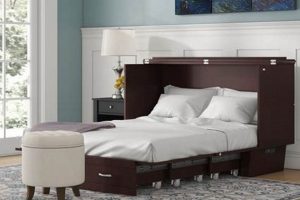
![Quick Air Bed Mattress Repair Kit: [Brand] Fixes Leaks! Organic & Natural Mattress Buyer’s Guide: Non-Toxic Sleep Solutions Quick Air Bed Mattress Repair Kit: [Brand] Fixes Leaks! | Organic & Natural Mattress Buyer’s Guide: Non-Toxic Sleep Solutions](https://mattressworldpa.com/wp-content/uploads/2025/07/th-7115-300x200.jpg)
